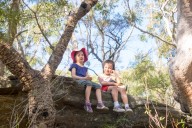Raising children in the West seems to be a case of indoor living. Why? The outside world is dangerous doncha’ know. But remove risk from your children’s lives and you might just be setting up them up for future failure…
I can think of few happier moments than watching my daughter Marilla, aged 5, and her friends clamber over rocks in Heathcote Creek. We were all there on our first overnight hike together (with my friends Garry and Ricardo). Why was I so happy? Because it was the children who had set the own agenda for that morning’s play. They were exploring a rugged environment full of both risk and reward. It was primeval. It was beautiful and all I’d done as a parent was take them there and let them be.
Risking it for happiness
Could they have slipped over? Sure. Could they have broken a leg? Yes, though a scraped knee was more likely. What was certain, however, was that they were learning fundamental survival and social skills, not to mention thinking creatively. And they were having a great time too.
I’m not suggesting that we should let young children run riot unsupervised in life-threatening situations (one dad was always keeping an eye on them) but there are two important things to note:
- We were actually outdoors in a wilderness environment (albeit one only an hour’s walk from a train station).
- We weren’t setting any rules about what the children could and couldn’t do, other than getting too close to a rock ledge: they were allowed to exercise judgement in the face of risk.
Intuitively, getting children outdoors in “risky” situations seems like a no-brainer. From an environmental perspective, children who have a connection to nature are likely to care about it. They are more likely to take on the role of custodians that as a species we seem to be shying away from en masse. But the benefits are personal too.

Afternoon joy: watching children form tribes and make new friends on their own terms is amazing, Gambells Rest, Morton NP
Taking risks improves self-esteem and problem solving
Richard Louv notes that there are direct benefits for the children who unplug from their device and get outdoors: “According to a range of studies, children in outdoor-education settings show increases in self-esteem, problem solving, and motivation to learn … Studies of children in schoolyards with both green areas and manufactured play areas have found that children engaged in more creative forms of play in the green areas, and they also played more cooperatively.”
Risking it on your front doorstep
As Louv, the writer who coined the term ‘nature deficit disorder’, suggests, this outdoor education doesn’t have to be in a wilderness area either. In fact, it could even be on your own street.
 Gardening out the front of the house: an easy way to get outdoors.
Gardening out the front of the house: an easy way to get outdoors.
UNSW Planning Student Anna Russell writes in her thesis Free Range Kids: Independence and the Urban Child that it can be as simple as letting your kids play out the front of your house. But why are our suburban streets so devoid of playing children? The changing nature of community is one reason. but above all it is because parents who dictate what risks children can and can’t take:
“More than actual risk of harm, more than neighbourhood design, more than a child’s capability to negotiate the environment safely, parents’ perceptions of risk dictate the freedom their child receives. Parents are acutely aware of the potential dangers of allowing their children to roam free. However there is little acknowledgement of the dangers of not allowing it.”
Does this mean parents should loosen up a bit? Absolutely. Does it mean that we should let kids go to pasture? No – but we need to keep the risks our children face in proportion and understand the dangers of raising kids in a risk-free setting.
Learning how to make mistakes
The University of Sydney’s Playground Project states that a consequence of risk aversion is that children can lack physical and emotional challenges, giving rise to undesirable behaviour such as bullying.

Negotiating (slightly) risky terrain in Georges River National Park. Risk aversion can give rise to undesirable behaviour later on in life.
The long-term consequences of risk avoidance are still not well understood. A lot of the research is actually centered on the benefits of free play (that is, play free of adult influence). However, it seems to me that the ability to make your own decisions in free pla is also the ability to take risks, to experiment with cause and consequence.
Part of this is the freedom to make mistakes and learn from them. It’s also critical to learn how to negotiate fear and adversity. And let’s face it, if life isn’t easy as a kid, it sure ain’t easy as an adult.
If we remove risk (and conflict) from our children’s lives, we could well be setting them up for failure. Tim McGill writes in his book No Fear: Growing Up in a Risk Averse Society that parents and governments should “embrace a philosophy of resilience: an affirmation of the value of children’s ability to recover and learn from adverse outcomes, whether these are accidents and injuries, failure, conflict, abuse, neglect, or even tragedy.”
There are lots of ways you can do this, but getting your kids outdoors and leaving them to their own devices is, to quote Marilla, easy-peasy, lemon-squeezey.














No Comments